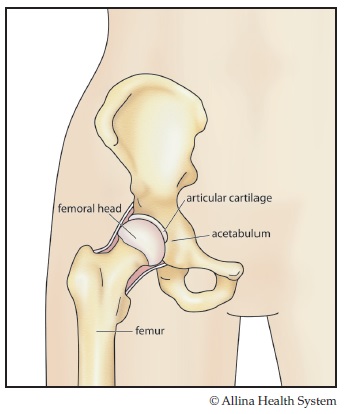
Understanding your hip
The normal hip
The hip is a ball and socket joint. The ball is formed by the head of the femur (the thigh bone). The socket is part of the pelvis called the acetabulum.
In a normal hip, the ball and socket are covered with a smooth layer of tissue called cartilage. The cartilage allows the ball to glide easily inside the socket and provides a cushion to your hip joint.
Muscle and ligaments hold your hip joint in place. When the surrounding muscles support your weight and the joint moves smoothly, you can walk without pain.

In the normal hip, the ball and socket are covered with a smooth layer of tissue (cartilage).

An X-ray shows the artificial joint (prosthesis).

An X-ray shows the artificial joint (prosthesis).
The problem hip
In the problem hip, the worn cartilage no longer serves as a cushion. When cartilage becomes damaged by an injury or by disease, the hip joint cannot move smoothly. As the cartilage wears away from the bones, the bones rub together and become irregular, creating a rough surface. The ball grinds in the socket when you move your leg causing pain and stiffness.
As the pain worsens, you will try not to use the joint as much. This causes the muscles to weaken and the joint to feel unstable and less able to support your body weight. An X-ray can determine the extent of joint damage.
A hip joint replacement is an option to relieve the pain and instability.
The hip after a hip replacement
The hip replacement surgery removes damaged bone and cartilage from the hip joint and replaces it with an artificial joint (prosthesis). An artificial ball connected to a stem replaces the ball of your thigh bone. An artificial cup, shaped like a bowl, replaces the worn socket. These parts connect to create a new artificial hip that works almost like your own hip joint. All parts have smooth surfaces for comfortable movement once you have healed from the surgery.
Typically the prosthesis is made of a wear-resistant plastic (polyethylene) and a metal (titanium, tantalum or cobalt). The artificial ball and socket are held in place by bone cement, your bone growing into the prosthesis or a combination of both. Your surgeon will determine which prosthesis will work best for you.
There are different approaches for hip replacement surgery, which change as the technology changes. Your surgeon will determine which approach will work best for you, based on your:
- age
- weight
- bone health
- overall health
- activity level
- specific hip degeneration or injury
The hip after a hip resurfacing
Hip resurfacing removes the damaged cartilage from the hip joint. The surgeon replaces the damaged cartilage with an artificial joint (prosthesis).
The artificial joint is made of two polished metal surfaces that rub together with the help of the body's natural joint fluid. The metal surfaces provide a smooth joint for movement.
The upper thigh bone (femur) is capped with a metal prosthesis. A metal cup is placed in the pelvis to replace the worn socket. The pelvic side is placed without cement. The cap on the upper thigh bone (femur) is held in place with bone cement.
Visit allinahealth.org/hipreplacementvideo to watch a video with more information about your hip.